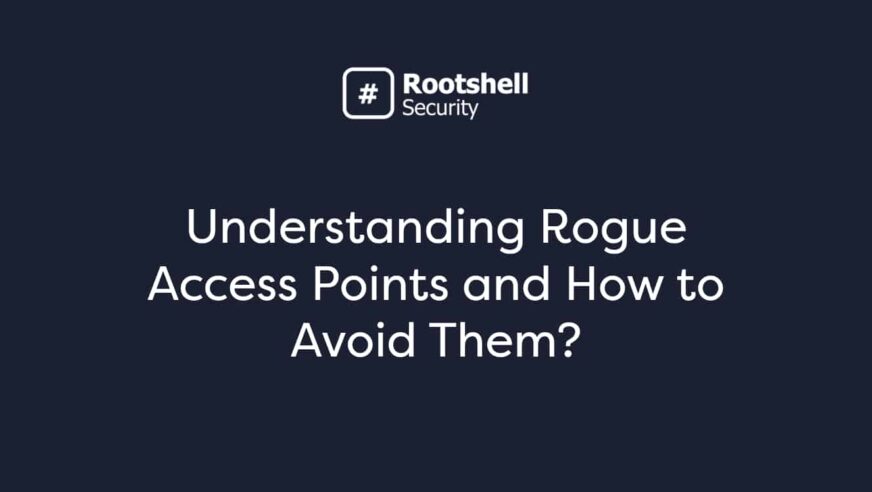Wireless networks have become central to how organizations operate, but they also present hidden security risks that many teams overlook.
One of the most common yet underestimated threats is the rogue access point, an unauthorized device that quietly undermines even the most secure systems. Rogue APs can appear in corporate offices, public spaces, or home networks, giving attackers a direct route into sensitive environments.
This guide explains what a rogue access point is, how to detect one, the dangers it poses, how it differs from evil twin networks, and the best practices every organization should follow to prevent rogue AP attacks.
What is a Rogue AP?
A rogue access point (AP) is a wireless device connected to a network without the knowledge or permission of the organization’s administrator.
These unauthorized access points create serious security gaps that cybercriminals can exploit to gain entry to private systems and data.
Rogue APs may be installed deliberately by attackers or unintentionally by employees attempting to create a stronger Wi-Fi signal or bypass network restrictions. Regardless of intent, they compromise the network’s integrity by providing an unmonitored entry point for unauthorized users.
Once active, a rogue AP allows anyone within range to connect to the network without proper authentication. This can lead to data interception, malware infections, and unauthorized access to sensitive files. Because these devices often operate outside the organization’s official security controls, they can be difficult to detect until damage has already been done.
How to Detect a Rogue AP
Detecting rogue access points requires both continuous monitoring and physical verification. Attackers often disguise rogue APs to resemble legitimate devices, making regular checks an important part of any organization’s network security process.
1. Network Scanning
Use wireless scanning tools to identify all access points operating within the organization’s range. Compare detected devices against the list of approved APs. Any unrecognized SSID or MAC address should be investigated immediately.
2. Network Monitoring Tools
Network monitoring software can detect irregular patterns in traffic, such as unknown devices transmitting data or communicating with suspicious IP addresses. Alerts should be configured to highlight new or unexpected connections.
3. Physical Inspection
Regular audits of office and equipment areas can uncover hidden or unauthorized devices. Employees should know how to recognize network hardware that appears unfamiliar or out of place.
4. Device Profiling
Advanced systems can analyze connected devices to confirm whether they match authorized hardware profiles. This method helps identify rogue APs that mimic approved devices.
5. Wireless Intrusion Detection Systems (WIDS)
WIDS technology scans for unauthorized APs in real time and can block connections from suspicious sources. Integrating this with network access control (NAC) strengthens overall detection capabilities.
How Rogue Access Points Work
Rogue access points (APs) function as unmonitored entry points into a network, bypassing the organization’s established security controls. They can be set up deliberately by attackers or unintentionally by employees, but in either case, they create a pathway for unauthorized access.
Once active, a rogue AP broadcasts a Wi-Fi signal that nearby devices can connect to, often without requiring proper authentication. These devices are not managed by IT, meaning they can be exploited to intercept data, distribute malware, or gain access to sensitive systems.
Cybercriminals may also configure rogue APs to mimic legitimate network signals, a technique known as evil twin attacks, tricking users into connecting and inadvertently exposing credentials or files.
Detection is challenging because rogue APs often operate silently, blending in with authorized network devices. They may use standard ports, common SSIDs, or even hidden networks to avoid notice. By the time a rogue AP is discovered, sensitive data may already have been compromised, highlighting the importance of proactive monitoring and strict network access controls.
Dangers of Rogue Access Points
Rogue access points expose businesses to multiple risks that extend beyond a simple network breach.
Data Theft
Attackers can use rogue APs to intercept login details, personal information, and confidential business data. Once inside, they can move laterally through the network and access restricted systems.
Malware and Ransomware
Rogue APs provide a route for attackers to inject malware into a network. The malware can then spread to connected devices, leading to service interruptions, data loss, or financial damage.
Man-in-the-Middle (MitM) Attacks
Cybercriminals can position a rogue AP between a user and the legitimate network. This allows them to capture communications, manipulate data transfers, or redirect users to malicious sites.
Denial of Service (DoS)
Some attackers use rogue APs to flood networks with unnecessary traffic, disrupting performance and preventing legitimate users from maintaining stable connections.
Network Instability
Even when not part of a targeted attack, unauthorized APs can interfere with signal strength, reduce bandwidth, and cause reliability issues across corporate Wi-Fi.
Differences Between Rogue APs and Evil Twins
Although rogue access points and evil twins share similarities, they represent two distinct threats. The following table summarizes their key differences.
Feature | Rogue Access Point | Evil Twin |
Definition | An unauthorized AP connected to a legitimate network without approval. | A fake Wi-Fi network designed to imitate a trusted one. |
Setup | Installed on or connected to the internal network. | Broadcasts a signal similar to a genuine network’s SSID. |
Intent | May be accidental (employee-created) or malicious (attacker-installed). | Always malicious, intended to trick users into connecting. |
Impact | Compromises internal systems and data. | Intercepts user communications and credentials. |
Detection | Identified through network scans and hardware audits. | Detected by analyzing Wi-Fi names, signal strength, and certificates. |
Access Type | Direct access to the internal network. | External access through a spoofed Wi-Fi connection. |
Both threats can cause harm if not discovered quickly. Rogue APs undermine network integrity from within, while evil twins target users externally by imitating trusted connections.
Key Features of Rogue Access Points
Rogue access points (APs) have several characteristics that make them a security threat. Recognizing these features can help organizations detect and mitigate risks early.
1. Unauthorized Connection
Rogue APs are connected to the network without IT approval, creating an unmonitored entry point for anyone within range.
2. Lack of Security Controls
Unlike authorized devices, rogue APs often lack proper encryption, strong passwords, or firmware updates, leaving the network vulnerable to attacks.
3. Hidden or Masqueraded SSIDs
Some rogue APs use familiar or hidden network names (SSIDs) to mimic legitimate access points, making it difficult for users and administrators to identify them.
4. Potential for Malware Distribution
Because rogue APs bypass network security policies, attackers can use them to deploy malware or intercept sensitive data from connected devices.
5. Difficult Detection
Rogue APs are often invisible to standard network monitoring tools and can remain undetected until unusual traffic or breaches are noticed.
6. Exploitable by Cybercriminals
Attackers can use rogue APs to carry out man-in-the-middle attacks, phishing attempts, or credential harvesting.
Best Practices for Preventing Rogue AP Attacks
Reducing the risk of rogue access points requires a combination of technical defenses, clear policies, and staff awareness. Below are the main measures to help safeguard a network.
Secure Physical Access
Limit access to network hardware and ports. All equipment should be clearly labeled, and unused ports should be disabled. Regular inspections of physical spaces can help identify unauthorized devices early.
Configure Wi-Fi Access Points Correctly
Approved access points should be secured using strong passwords, encryption (such as WPA3), and the latest firmware updates. Disable unnecessary features and guest networks where possible.
Implement Network Monitoring
Continuous monitoring helps detect unusual traffic or unauthorized devices. Automated alerts can notify administrators when new APs appear or network configurations change.
Apply Network Segmentation
Separating devices into smaller network zones reduces the impact of a breach. If a rogue AP connects to one area, it limits the attacker’s ability to reach other important systems.
Educate Employees
Many rogue APs are created by staff who are unaware of the risks. Provide training on Wi-Fi policies, explain why connecting personal routers is unsafe, and encourage employees to report suspicious devices.
Establish Clear Security Policies
Create a company-wide policy prohibiting the installation of any wireless device without IT approval. Offer a safe reporting process for employees who may have unknowingly installed one.
Conduct Regular Security Audits
Frequent network assessments help maintain visibility over all devices. Penetration testing and vulnerability scans can uncover hidden access points and weak configurations.
Use Zero Trust Architecture
Adopting a Zero Trust model means every user and device must be authenticated before accessing resources. This approach significantly reduces the likelihood of rogue APs gaining access to sensitive areas of the network.
Authorized vs. Rogue Access Points
Not all wireless access points are created equal. Understanding the difference between authorized and rogue APs is essential for maintaining network security.
Authorized Access Points
Authorized Access Points are legitimate devices installed and managed by an organization’s IT team. They are configured with strong security measures, such as WPA3 encryption, complex passwords, and network monitoring.
Authorized APs are integrated into the company’s security protocols, regularly updated, and subject to audits, ensuring that only approved users can access the network.
Rogue Access Points
Rogue Access Points, by contrast, are unauthorized devices connected to a network without approval. These may be installed intentionally by attackers to gain entry, or accidentally by employees seeking better Wi-Fi coverage. Unlike authorized APs, rogue devices operate outside of security controls, often without encryption or monitoring.
This makes them a prime target for cybercriminals and a serious risk for data breaches, malware infections, and unauthorized access to sensitive systems.
Public Wi-Fi Risks and Rogue Access Points
Public Wi-Fi networks, such as those found in airports, hotels, cafés, and libraries, are particularly vulnerable to rogue access point attacks. Because these networks are often open or minimally secured, attackers can easily create fake hotspots that appear legitimate.
For example, a cybercriminal might set up a network named “Airport_Free_WiFi” that looks identical to the official one. Unsuspecting users connect to it, allowing the attacker to intercept sensitive information such as login credentials, credit card details, or confidential emails.
Even when using genuine public Wi-Fi, users face risks if network administrators haven’t properly secured their systems. Rogue APs can blend in seamlessly with authorized devices, making it nearly impossible for the average user to tell the difference.
To stay safe on public Wi-Fi:
- Avoid connecting to open networks that don’t require passwords.
- Verify the correct network name with the staff before connecting.
- Use a VPN to encrypt your data.
- Disable automatic Wi-Fi connection on your devices.
Whether in a coffee shop or an airport lounge, treating public Wi-Fi as inherently untrustworthy is one of the easiest ways to avoid rogue AP threats.
Why Rogue APs Are a Growing Threat
Hybrid working, cloud collaboration tools, and IoT (Internet of Things) devices have dramatically increased the number of wireless networks organizations depend on. While this flexibility enables productivity, it also creates more opportunities for rogue access points to emerge.
Today’s workplaces see employees connecting personal devices, smart speakers, or unauthorized routers to improve Wi-Fi coverage, actions that, while well-intentioned, can inadvertently create backdoors into corporate systems.
Attackers also exploit the widespread availability of portable routers and Wi-Fi repeaters, which can be deployed in minutes and are difficult to detect without proper monitoring tools. In large offices, co-working spaces, or shared facilities, this makes rogue APs particularly dangerous, as they can operate undetected within legitimate network environments.
According to a 2024 report by Nozomi Networks Labs, which analyzed over 500,000 wireless networks globally, only 6% were adequately protected against wireless de-authentication attacks, meaning 94% remain vulnerable to potential exploitation. This highlights just how exposed many environments are to rogue APs and similar wireless threats.
In short, the modern digital workplace has expanded the attack surface, and rogue access points are exploiting those gaps more than ever.
Protect Your Network from Rogue Access Points
Rogue access points are a silent but serious threat to modern networks, capable of exposing sensitive data, enabling malware, and compromising organizational systems.
The key to mitigating these risks lies in proactive detection, strong access controls, and continuous monitoring. To make sure your network is fully protected against rogue APs and other wireless threats, consider a wireless penetration test. These services can identify hidden access points, misconfigurations, and other vulnerabilities before attackers exploit them.
Take the first step in securing your network today. Book a demo with Rootshell Security to discover how expert solutions can protect your wireless environment and strengthen your overall cyber resilience.



